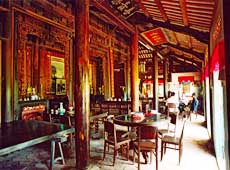About 40 kilometers from the center of HCMC on National Road No.50, heading to Cau Ngang hamlet in Long Huu Dong commune, Long An province’s Can Duoc district, Tram Cot (hundred pillars) House is striking as an ancient work of sculptural architecture which was recognized as one of the national historical and cultural relics in 1997 by the Ministry of Culture, Sports and Tourism.
 Completed in 1903, the house was meticulously carved with precious woods such as kingwood, ebony, redwood and iron wood in the style of houses of rich families in the Central Highlands. More than 100 years old, the house is preserved as what it used to be.
Completed in 1903, the house was meticulously carved with precious woods such as kingwood, ebony, redwood and iron wood in the style of houses of rich families in the Central Highlands. More than 100 years old, the house is preserved as what it used to be.
Tran Van Ngo, the third-generation owner of the house, said that the house was built by his grandfather who hired artisans and workers to carve for three years and set up for two years.
The house is located on an area of 882 square meters and surrounded by a garden area of over 4,000 square meters. It includes spaces and two roofs. Its pillars and walls were carved skillfully as bas-reliefs with images of dragons, phoenixes, turtles and lions and flowers such as orchids, daisies and apricots as well as images of typical Southern fruits. The house now has 120 pillars, comprising 68 round pillars and 52 square pillars; it originally had 160 pillars when it was built, said Tran Thi Ngo, wife of Ngo.
Inside the house, many wooden utensils such as tables, beds and trestle-beds as well as plates which are intricately carved and many ceramic objects of the Nguyen Dynasty are still carefully kept.
The house has welcomed many visitors. Nowadays, it is an attractive place for people, especially who are interested in the traditional art of Viet Nam. It is recommended place for tourists when they visit Long An.